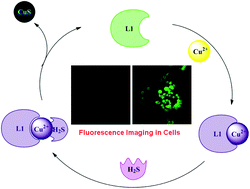Recognition of copper and hydrogen sulfide in vitro using a fluorescein derivative indicator†
Abstract
We report the development of a fluorescein-based chemosensor (L1) for monitoring ions or micromolecules (H2S). Copper ions are known to be toxic at high concentrations and hydrogen sulfide induces various problems. Herein we develop a simple method for detecting Cu(II) and H2S with high selectivity and sensitivity. The chemosensor L1 displays on–off–on type fluorescence change with alternately added Cu(II) and H2S to the media along with reversible forming–separating of the complex. The potential biomedical relevance of the chemical mechanisms involved in the detection of L1 is described.


 Please wait while we load your content...
Please wait while we load your content...